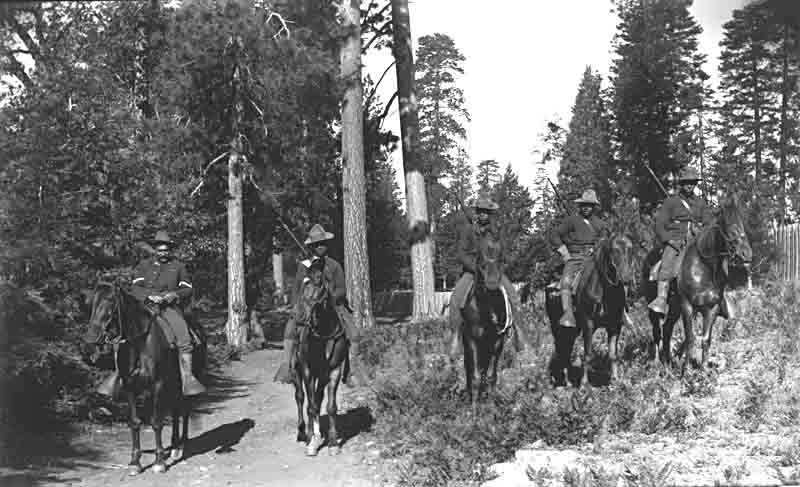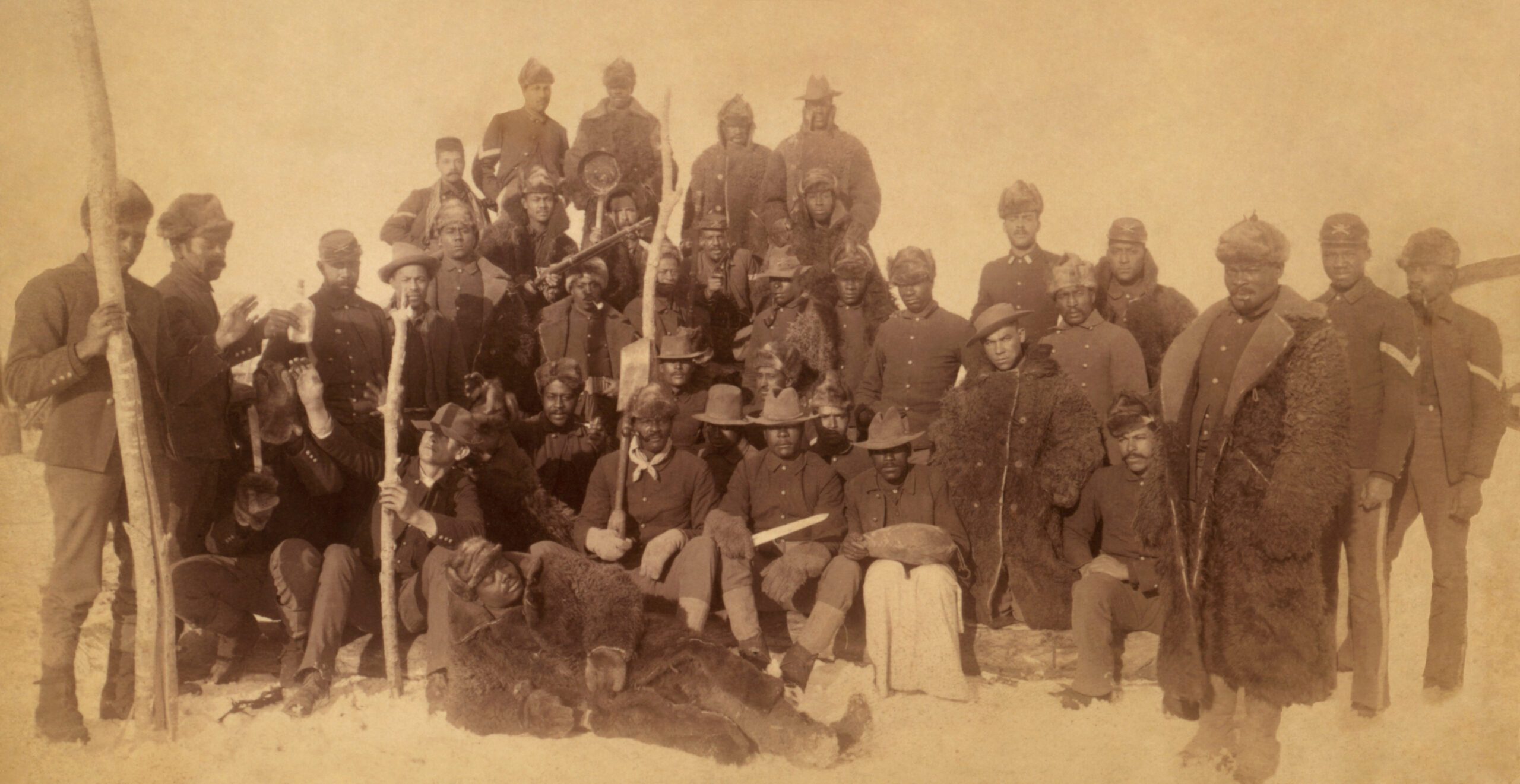The Proud Legacy of the Buffalo Soldiers, the Black Army Unit Tasked with Preserving our First National Parks
While widely known for their service on the Frontier, the Black U.S. Army unit known as Buffalo Soldiers was later deployed to create and protect Yosemite and Sequoia parks for generations to come. This chapter of their military service is an often-forgotten legacy of the vital role Black people played in the preservation of what is today the National Park System.
Stationed at the garrison of the Presidio in San Francisco in the spring of 1903, a battalion of Black United States Army men received orders for a remote deployment. After serving their country in heavy combat through the Plains Wars for Western Expansion of the United States and overseas wars in Cuba and the Philippines, many of those men were likely curious to know where they were being sent, but few were reluctant to go wherever duty called. The 9th and 10th Cavalry, along with the 24th and 25th Infantry—units collectively known as the Buffalo Soldiers—mustered out to ride and march in parade formation past the Lombard Gate, bound for their next assignment.
The much-coveted Yosemite duty station in the verdant mountains and valleys of central California was known among officers as “Cavalryman’s Paradise.” Less than 50 years after emancipation, a tour of service among the giant sequoias and redwood trees along the banks of the Merced River might have seemed like heaven to many Black Americans.
Today, Yosemite National Park Ranger Shelton Johnson imagines what a white sentry might have thought, and even said aloud, as over 400 Black men set out on foot, on horseback, and in wagons for their 14-day journey east toward the Sierra Nevada Mountains.
“It just ain’t fair. These Niggers are going to Yosemite. This is a white man’s job! What’s this army coming to?” Johnson proclaims in the role and uniform of Sergeant Elizy Boman, one of the men among the original deployment, in a historical retelling captured in Ken Burns’ PBS short film, Yosemite’s Buffalo Soldiers. “It was then and there that I decided that this was good duty. Because if that sentry wanted to be in Yosemite, then maybe we should be there too.”
How the Buffalo Soldiers Got Their Name
The history of people on public land throughout North America is a complicated mix of both triumph and tragedy. The Buffalo Soldiers owe their name to the Native tribes they fought during the Plains Wars of 1865 through 1924, when, ironically, as sons of former slaves, they were tasked with removing Native peoples across the West in service to a nation that didn’t yet consider them full citizens. Yet they managed to serve with such distinction, they were honored by the very people they were ordered to displace.
“According to the legend of how they got their name, the Native Americans believed that the curly hair they had reminded them of the hair between the horns of a buffalo and their black faces,” says modern-day Presidio interpretive ranger Frederick Penn. “And also, how tenaciously the Buffalo Soldiers fought them. They fought with the spirit of the buffalo.”
Our Very First National Park Rangers?
Despite the persistence of racial discrimination through much of the 20th century, this all-Black U.S. army unit men was charged with the protection and preservation of the newly designated public lands of Yosemite and Sequoia for the enjoyment of the American public.

Buffalo Soldiers Riding in the Forest in Yosemite National Park
Led by Captain Charles Young, himself only the third Black American to graduate from the military academy at West Point, the Buffalo Soldiers aimed in a time of peace—more than a decade before the start of World War I—to defend the natural landscape from forest fires, poaching, illegal logging, and even littering. It’s safe to say they were among our very first National Park Rangers.
Under Captain Young’s leadership, it’s believed the Buffalo Soldiers accomplished more in three summer deployments than all previous military operations combined. During their management of Yosemite and Sequoia, the men set many of the standards for environmental stewardship that we still follow today. They created the first national park natural history museum. They also built campsites, picnic areas, hiking trails, and roads, many of which are still in use today, like the path to the summit of Mount Whitney, the highest peak in the lower 48 United States.
Meanwhile, as the first Black superintendent of Sequoia National Park, Captain Young established the preservation policies that protected the park’s giant redwood trees from being cut for timber, ensuring visitors can still marvel at the trees’ ancient beauty to this day.
From Racial Segregation to Inclusion in the Parks
Sadly, when the National Park Service was created in 1916 it, like most government agencies, was racially segregated. The same Buffalo Soldiers who helped to create Yosemite and Sequoia were disqualified, because of the color of their skin, to serve again as official national park rangers in civilian life. While Interior Secretary Harold Ickes mandated national park desegregation in 1945, it took years before his dictum was finally realized. Even two decades later, Black men and women would have been denied access, even as tourists, to most national park campgrounds and nearby hotels during the Jim Crow era of the 1960s.
It’s only now, in the 21st century, that the Buffalo Soldiers story has become a compelling narrative that firmly grounds Black Americans in the history of National Park preservation. Today, Yosemite’s Ranger Johnson tells audiences the world over about the contributions of the Black men who helped steward America’s best idea—our national parks.
“When I see myself wearing this uniform, I’m also making a challenge that people of my culture can also be a part of this history. We are a part of this history,” Ranger Johnson says. “That’s the value of the Buffalo Soldier story. It’s stating that at the very beginning of this great invention, this great contribution to world culture, which is of course America’s best idea, that we were part of it from the very beginning.”
——–
James Edward Mills is the author of The Adventure Gap: Changing the Face of the Outdoors and the co-writer/co-producer of An American Ascent. He has worked as a guide, outfitter, writer, and photographer since 1989 and was named a Yosemite National Park Centennial Ambassador in 2016. Follow him on Instagram and online at The Joy Trip Project.

